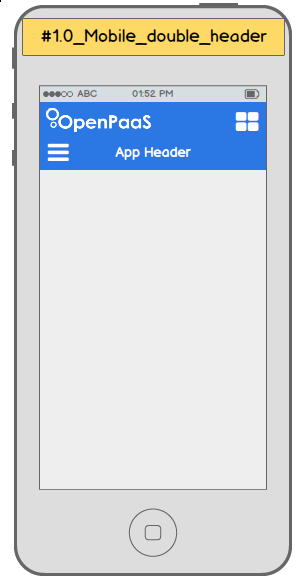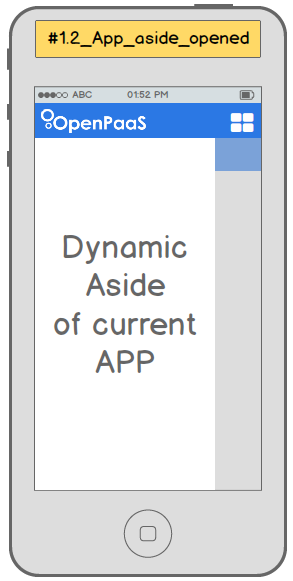2 - OpenPaas compliant mobile template
We have some specific rules for each mobile templates to keep consistency and ease OpenPaas usage by an end user. Fortunately we created a bunch of helpers.
What do it looks like?
Every views including in a OpenPaas module will look like this:

As you can see, we have 2 headers:
- The very top header (with the openpaas logo) is composed by the logo and the application grid button.
This header is automatically included in each pages. Also on scroll down this header will disappear and the second header will take the place. We are doing it to gain more space.
-
The second header is special, it is compiled using the dynamic-directive module. It allows us to compile a different header for each view with actions depending on the scope or the application and current view context.
-
Finally a right aside will be used to enhanced the interaction possible in the view.

The whole grey background is now the content of the view.
The subheader system
To use the subheader system, your new module will have to include the esn.header module, exposing itself a headerService.
angular.module('your.new.module', ['esn.header']);
Now in each controllers of each views you have to:
- create a the directives holding the header template:
.directive('mymoduleHeaderMobile', function() {
return {
restrict: 'E',
replace: true,
templateUrl: '/mymodule/views/mymodule/mymodule-header-mobile.html'
};
})
.directive('mymoduleHeaderContent', function() {
return {
restrict: 'E',
replace: true,
template: '<span>My Module</span>'
};
})
- inject the header template you want with (Do not forget to remove the header on $destroy):
angular.module('your.new.module', ['esn.header'])
.controller('myController1', function($scope, headerService) {
headerService.mainHeader.addInjection('mymodule-header-content');
headerService.subHeader.addInjection('mymodule-header-mobile', $scope);
$scope.on('$destroy', function() {
headerService.resetAllInjections();
});
});
The aside system
This one is simpler than the subheader. First include esn.sidebar in your module:
angular.module('your.new.module', ['esn.sidebar']);
Then in any template, use the new contextual-sidebar directive like so:
a(href='', contextual-sidebar, data-content-template="/mymodule/views/mymodule/mymodule-sidebar")
It will bind the element on click and open a right sidebar compiled with the given template.
